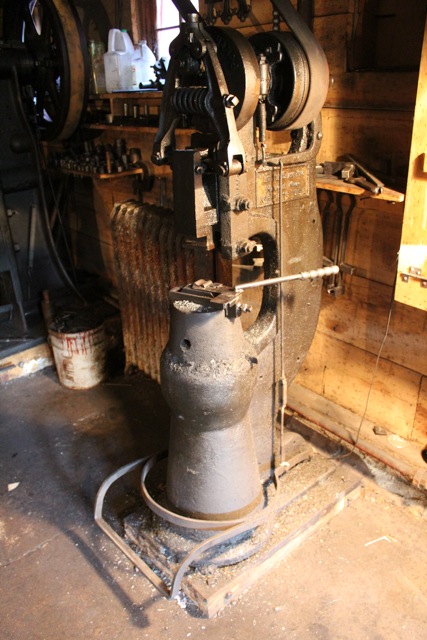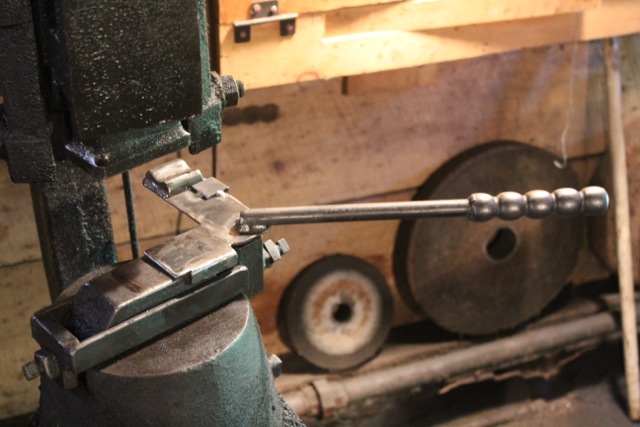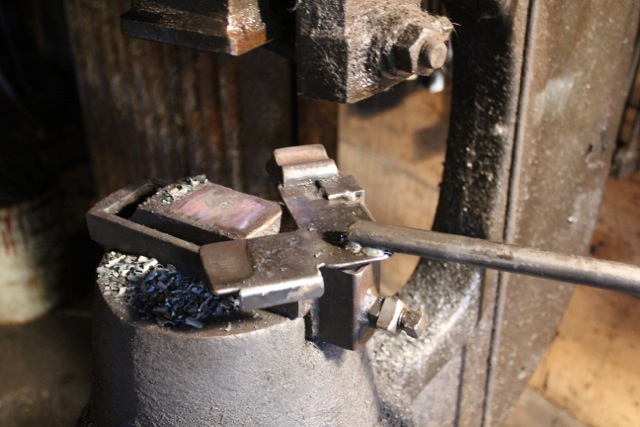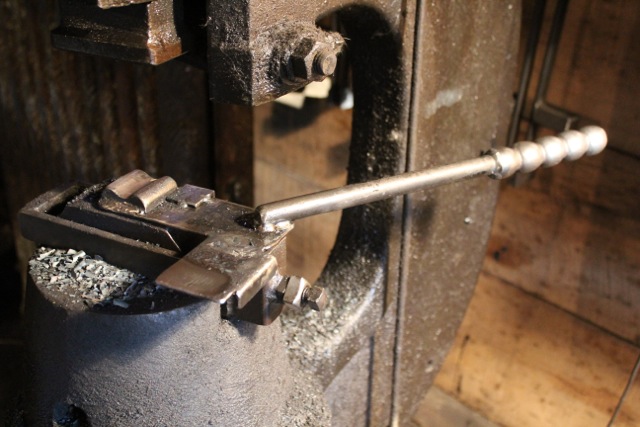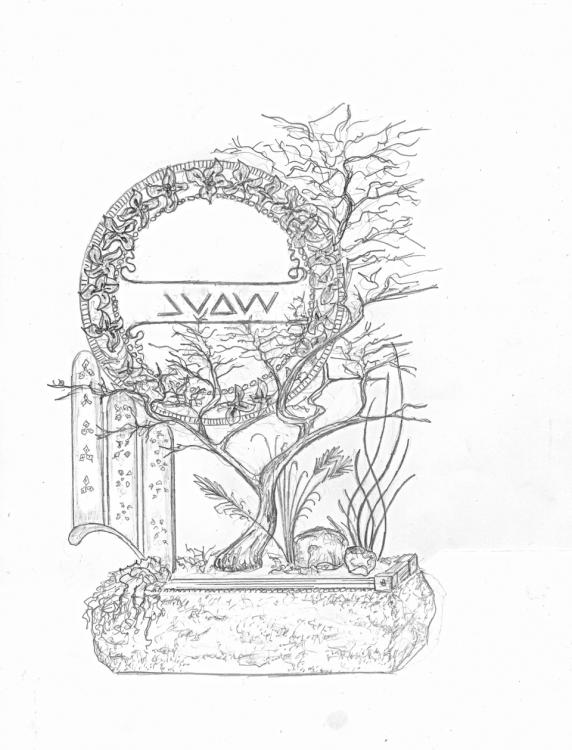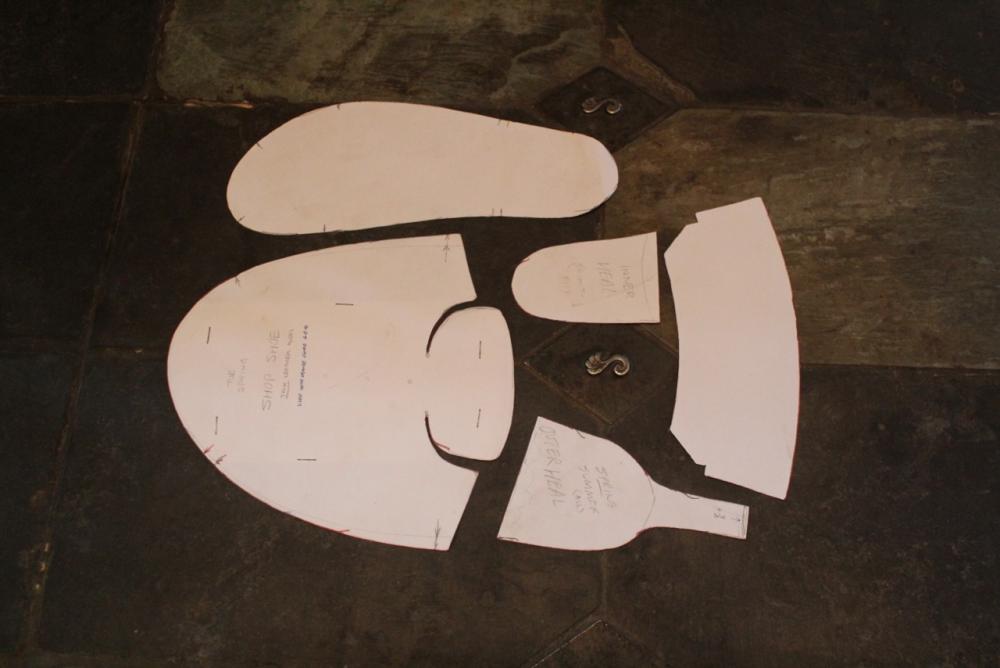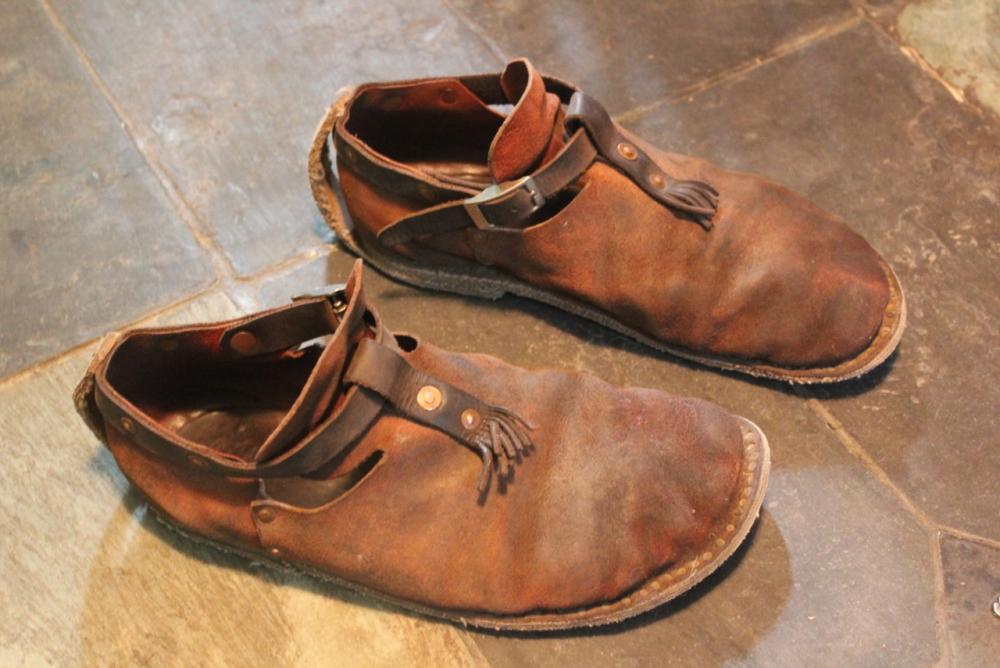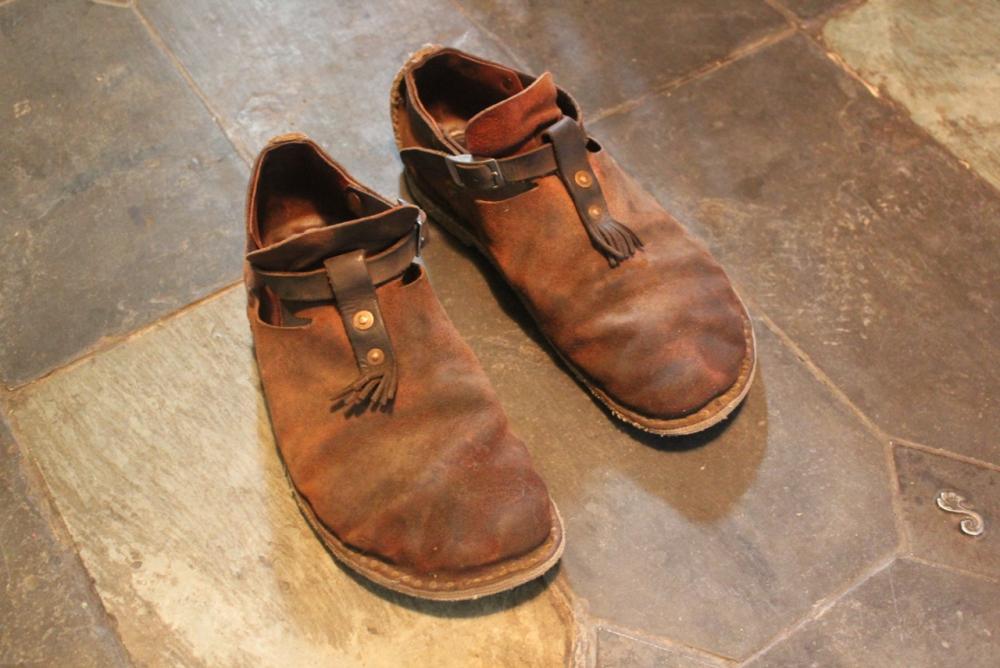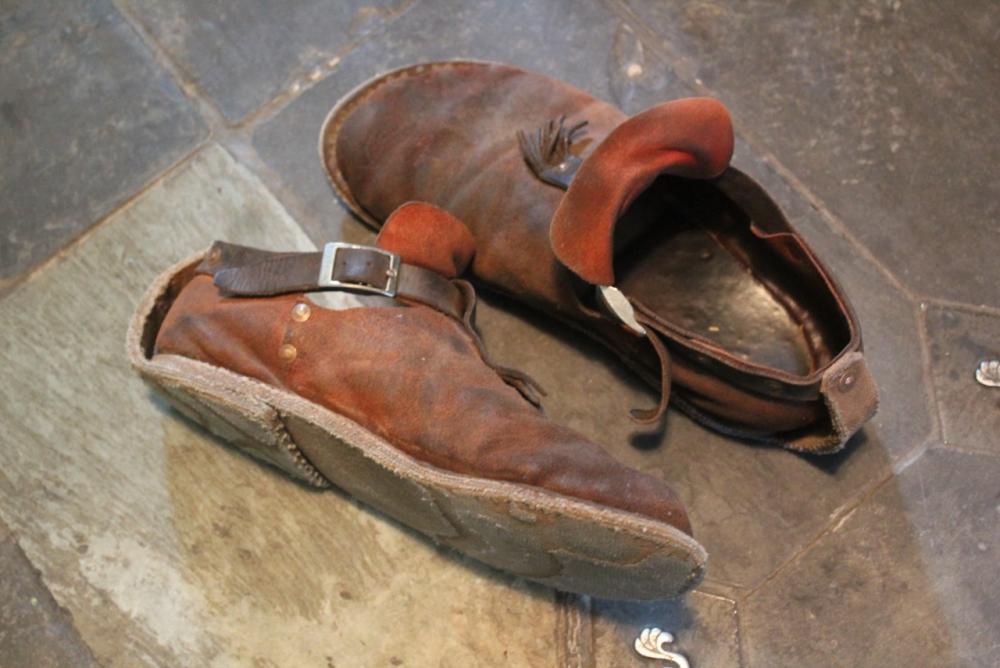-
Posts
158 -
Joined
-
Last visited
Content Type
Profiles
Forums
Articles
Gallery
Downloads
Events
Everything posted by Sanderson Iron
-

How big of a hammer
Sanderson Iron replied to Millennial Blacksmith's topic in Power Hammers, Treadle Hammers, Olivers
It's back to trading versatility for convenience. You're right that a lot of people don't want to do make adjustments--or know how to make them. The press awareness that's been growing for some time is good, because it allows more things to be done with iron, letting our craft be appealing to a broader range of people. Thanks for the links, Alan. The old IFI link is void of pictures, at least on my fruit-flavored computer, but the U-tube link came through fine. It's a good example of an air hammer being used for large, robust work. As I've been saying, it's the light end that they lack. Of course, this video shows a hammer much larger than any vertical mechanical, so we really should compare similar weights, I suppose. joel -

How big of a hammer
Sanderson Iron replied to Millennial Blacksmith's topic in Power Hammers, Treadle Hammers, Olivers
Okay, so can I say they're ugly? Really ugly? Will that make fewer people mad? And I agree that there are a lot of mechanicals which are not as versatile as a Murray. I have tried to specify "Little Giant" (LG) style hammer in my discussion. That design is one of the best configured and efficient hammers ever made, and it can do things, make movements, that no self contained hammer can ever do. Not quite true. The spring gives the ram a snap at the top of the cycle, throwing it downwards for the next blow. If your workpiece is tall enough to be, say, midway in the cycle, you can have a very fast "actual strike speed" (feet per minute)--faster, in fact, than with a weaker spring setting which wouldn't give it that fast return. On the other hand, if you want to strike a single dead blow, loosening the spring so that it does not arrest the ram at the bottom of the cycle can result in a harder single hit. Yes, but there is a very significant difference between how a mechanical hammer and an air hammer tackles this problem (of hitting a tall object). You see, an air hammer has a more or less fixed cycle--it can't be raised or lowered--so all it has to work with is the stroke in that one cycle position. That's why it can't get its speed up and is weak on the top. A mechanical can raise its cycle. This lets it hit high or low with equal movement and full power. True. I gave that example to illustrate to our friendly Massey Dude that a mechanical is perfectly able to hit light fast blows, and that sometimes that happens automatically, all with the same setting. Keep in mind, "fast blows" is all the air hammer is capable of doing. The ability to be adjusted in order to get different kinds of blows--other than fast--is one of the many virtues of a mechanical hammer, as I have said before. Some people confuse versatile with convenient; but of course, if you can't make the machine do what it's capable of, it's not as versatile as it could be, so it's tempting to trade versatility for convenience. That's what air hammers do, but at a huge sacrifice. -

How big of a hammer
Sanderson Iron replied to Millennial Blacksmith's topic in Power Hammers, Treadle Hammers, Olivers
Very true. To upset very far with my hammer, I have to change the ram height as it gets lower. Of course, you can get around these problems by working downwards with tooling (like grooves or bolsters in the lower die and so on) or upwards with blocking. A friend of mine has a bottom die with grooves on his Bradley, so he can hit a bar flat and then stick it down in the groove in his die to hit the edge, all with one setting. You don't have to jump through these hoops with an air hammer. Any I have run has less power at the top of the stroke. The ram just cannot get its speed up, since there is less movement or stroke. In comparison, a LG can make a full stroke, full cycle, with full power, all the way to the top of its setting--as long as you're working within its capacity, of course. I expect your Beaudry does too. I think the Bradley guys would disagree with this! The more versatile your shop is, the more diverse your work can be of course, so your dream of having lots of hammers is a wonderful idea. I suppose if a person had the room and money, an air next to a mechanical would be a good combination, but you'd have to be good with them both. It's kinda like a rifle: a man with one rifle usually is a better shot than the fellow with a collection of rifles, with one for any occasion. Of course, here I am with three hammers, so I really shouldn't talk. -

How big of a hammer
Sanderson Iron replied to Millennial Blacksmith's topic in Power Hammers, Treadle Hammers, Olivers
I believe a Massey hammer would be an air hammer. Apparently not so versed in mechanical hammers. -

How big of a hammer
Sanderson Iron replied to Millennial Blacksmith's topic in Power Hammers, Treadle Hammers, Olivers
That is blatantly false, nonjic. That is a myth propagated by the air hammer salesmen and air hammer enthusiasts who do not understand how mechanical hammers operate. A mechanical LG style hammer can hit lightly as fast as it can run. I will give yet another simple example: It is possible to raise the ram of a LG mechanical so that when it is run full speed, the dies barely touch. Did you know that? If you raise the ram 1/2", it will barely touch a 1/2" thick bar. That means a very light blow. Understand? Now if you put a 2" bar between the dies and hammer it wide open, it will hit very hard, with powerful dead blows. If you're drawing that bar down to a taper with a 1/2" end, by the time you get to the smaller end, you'll be hitting fast and light again. Does this make sense? Fast and light on small section, hard and dead on the large section--all with the same hammer setting--just like it should be. You might like an air hammer, and that's fine, but facts are facts, and air hammers do not offer as much variation in the kind of blows they can make. They're one speed, and whether you like one or not, that limits what kind of blows they make. I'm not sure what armchair b.s. you're talking about, and your blanket statement kind of insulted everyone here at once. Everything here should be pretty clear even to an air hammer operator who has never run a mechanical--if in fact he runs a hammer at all. We don't know all the people here, so I think we should give everyone respect in the benefit of the doubt. -

How big of a hammer
Sanderson Iron replied to Millennial Blacksmith's topic in Power Hammers, Treadle Hammers, Olivers
When I talk about pushing with a mechanical, I don't mean squeezing like a press, with its full power behind it, or like the Chambersburg with air pressure. When you slow a mechanical's ram down, you can push a drift through a hole in one fluid motion; that's what I mean by pushing. That's a lot different than driving it through with a series of fast taps, as you well know, but it's not a squeeze. The Little Giants and Murrays cannot squeeze appreciably. They cannot lock the ram either, at least not beyond the strength of the brake (if it has one) and the spring. A Hackney can lock the ram very securely. It still doesn't give a press-like squeeze, like some air hammers can, but it holds very nicely. (For those who aren't familiar with a Hackney, it's a mechanical air hammer, an atmospheric hammer it has been called, with a variable air spring. It has a brake directly on the ram, which can lock it anywhere in its stroke. Mine has a cone clutch for variable speed.) The level or slightly up rule of thumb is mostly for wide open forging, where the spring has to counter the fast blow. If you want to hit a slower, dead blow, or if you want a little more range of motion (like with a smaller hammer that doesn't have much room) running with the spring looser so the arms are lower is a help. The more you get used to the vocabulary offered by these mechanical variations, the more you can do with your hammer, unlike an air hammer which is caught in just one or two modes. (I just had to throw that in there!) I hope this hammer discussion is helping the Millennial Blacksmith, wherever he wandered off to. -

How big of a hammer
Sanderson Iron replied to Millennial Blacksmith's topic in Power Hammers, Treadle Hammers, Olivers
No, you've got it backwards there, Alan. Thats partly what I've been trying, unsuccessfully, to explain. The Murray can run fast and light or fast and heavy or anywhere within its range. In fact, in my illustration above, if you start out with a 2" bar forged to a 1/2" taper, it can hit hard and fast on the thicker cross section and light and fast on the thinner, with the same setting. The speed doesn't have to change at all. I can run the Murray wide open and barely tap a 1/4" round, or I can run wide open and smash 2" round. The spring is doing what your air does--it arrests the motion and turns the ram about for the return. When it begins that arrest is determined by the height of the ram and the tension on the spring, so for heavy blows you set it to leave the energy in the ram. So you see, it doesn't have to be the "whip lash" that you're thinking. That is exactly what a mechanical can do. That's what they're made to do. As far as power of a given hammer goes, that just depends on the machine. Clifton came to our shop in the early 90's and ran the 200 lb Chambersburg I mentioned, and he told us at the time that it had more power than his 250 lb Murray. (My, that man can move metal!) A 200 lb Nazel is lighter than the 200 lb Chambersburg too. My 100 lb Hackney doesn't hit anywhere near as hard as a 100 lb Little Giant, because it has a shorter stroke. But we've been talking about control and variation of blow, not power. Joel -

How big of a hammer
Sanderson Iron replied to Millennial Blacksmith's topic in Power Hammers, Treadle Hammers, Olivers
Yes, the air adds force, and some air hammers can squeeze only, though many air hammers cannot. The first air hammer I worked around, a Chambersburg, could squeeze, and it was handy from time to time. However, nearly all of the work still is done with repeated blows, so most of the forging still has the full-speed problem with tooling. Also, with that machine, it is not possible to gently set the ram down on the work to squeeze it--it still has to tap tap tap its way down, hitting the work multiple times before it finally does any squeezing. I expect that's true of your air hammer too, though I don't know of course. It's not so with a mechanical. I can set the ram of my 100 pounder down on the work or gently push in one movement. Another adjustment on a mechanical, which many people don't use, is the spring tension. Clifton taught most of us that the spring needs to be kept stiff, to give an elastic blow. In my experience, that adjustment is there for a reason, and it's another great thing about that type of hammer. You can change the blow from an elastic blow to a dead blow by loosing the spring. (I'm answering your question, Mr. Evans.) Some hammer manufacturers actually advertised that they made a dead blow (I think the Shaw did) so obviously someone else besides me thinks this is useful. It is particularly useful if you have a hammer without a brake, like LGs came from the factory. You can loosen the spring and hit one blow, and you can push much more easily. This opens up an even bigger window of variation for the mechanical hammer that cannot be approached with an air hammer. All this variation means greater application and usefulness. I hear people argue that with a mechanical you have to stop all the time and change the adjustment. Nonsense. With my 250 I can go from drifting a hole with the tooling stacked 4" high to hitting the work 1/2" thick. It's no problem at all. I can forge a 2" bar (or more) down to a taper 3/8" round without any adjustment whatsoever, and the hammer runs just right for all of it. In fact, it'll hit nice and fast and light for that smaller dimension--just what you want to do. Let's say you're making railing, and you have 40 bars to forge, each with a boss left on the end, which will be turned into, let's say, a fan. You start with a spring fuller to separate the boss, so you want to run nice and slowly and controlled. (I don't know anyone who would prefer to do this operation at a high tappy speed.) Set the hammer to run slowly and light; you're just pushing the tool into the iron. Do all 40 bars, then change the hammer for the next operation, drawing. There's no down time--you're just shifting gears every few hours, mechanically and mentally. It takes as long to get a drink from the fridge. So the next operation is fast and hard, so change the setting. Do all 40 bars. Then maybe you want to swage the base, so you set the hammer to hit fast and light. Do all 40 bars, and so on. This is how these mechanicals were made to be run--in production situations where achieving the most efficient type of blow is possible. No self contained hammer I have ever seen can touch that. Thank you, Beaudry. I appreciate the very nice compliment. P.S. I can answer your questions about the press later if you want, Mr. Evans. This post is getting pretty windy already. j. -

How big of a hammer
Sanderson Iron replied to Millennial Blacksmith's topic in Power Hammers, Treadle Hammers, Olivers
Goodness me, who in the world told you that? That is totally untrue. I forge with a toggle press as much as I forge with a hammer. Maybe you could explore a little more the potential of mechanical forging machines in general. Not struggling at all. Putting your hand under a running machine is quite a bit more risky than putting your hand under one which is stationary. The air hammers' ram is always snuffing and running--it has to be to be raised. A mechanical just hangs there, like I said, or it is held with a brake. Seems sensible to me. I sure don't see a "cannot" in there, which you falsely claimed I said. If all you want to do is strike the metal between the hammer's dies, an air hammer might be fine. If you want more varied blows for use with tooling, get a mechanical. An air hammer cannot do all the variation that a mechanical can. It's pretty simple to understand why that'd make them more versatile and better for varied tooling. One machine with a broader spectrum means a broader application. Joel -

How big of a hammer
Sanderson Iron replied to Millennial Blacksmith's topic in Power Hammers, Treadle Hammers, Olivers
In neither of your quotes did I say that a self contained hammer "cannot be used with tooling." I never said that. I said they are better without tooling, better for direct hammering between the dies, that if all you want to do is smash metal, it might be the hammer for you. I never said they cannot be used with tooling, so please get over it. Don't claim I said something I did not. A self contained hammer's action is not as varied as a mechanical hammer's, which gives a mechanical a wider range of application, including for use with tooling. A mechanical hammer can make every type of blow that a pneumatic can make, but the reverse is not true. Joel -

How big of a hammer
Sanderson Iron replied to Millennial Blacksmith's topic in Power Hammers, Treadle Hammers, Olivers
Yeah, yeah, yeah. That was silly analogy. The ram and its links slow and stop though--that's what I was trying to point out, and the air hammers are always snuffing up and down at their wide open speed. Is it easier to arrest the motion of a 300 cpm object or a 3 cpm object? Here is another way of looking at it, which Clifton told me years ago. If you take your arm, lay it on a table and slap it a fast blow with your other hand, you'll feel it on the top of your arm--the skin--but if you press it against the table with your other hand, you'll feel it throughout your arm, clear to the bottom against the table. That's the difference in affect between a press and a hammer, a fast blow and a slow one. One works the surface, the other the entire cross section, even if the energy involved is the same. A mechanical's ability to slow its movement gives it the ability to push and not just slap the surface. That makes a big difference when you want to push a drift through, bend, straighten and so on. Not meaning to argue with you, but what self contained hammer was made in the 1860's? I understood that the order of hammers was (more or less): trip, steam, atmospheric, mechanical, self contained, with drop mixed in there somewhere. I think the reason for the lack of mechanical hammers being made is the cast iron involved and the idea that self contained hammers are new and modern and all that. They don't offer a hammering package as diverse as the mechanicals do, but since salesman like yourself can take a self contained hammer to a demo and show it more easily (it is after all, self contained) it has made them more popular than if the mechanicals had had the same promotion. Nothing wrong with selling hammers, don't get me wrong. Thank you for helping people get them. Joel -

How big of a hammer
Sanderson Iron replied to Millennial Blacksmith's topic in Power Hammers, Treadle Hammers, Olivers
No, Mr. Dwarf, I did not say that. I said the following: Don't get a self contained air hammer (Kuhn, Sahindler, Chamberserg, Nazel, bla bla bla). They're terrible machines. If all you want to do is smash metal between the dies, without using any tooling, and if you always want to hit it at the same speed, then by all means get an air hammer. But if you want power and control, with variable, controlled blows, get a vertical mechanical hammer. The worst designed mechanical is more controllable than the best self contained hammer. I'll rephrase that: if you are not a person who is really interested in using tooling under the hammer, or if your work does not require it (like for damascus and so on) an air hammer might be the machine for you; it might even be better than a mechanical. However, if you're the kind of smith who is really intrigued by using hand held tools, doesn't want to use an anvil, wants to do everything under the hammer, then a mechanical hammer is better because it has more variation to its blows and has broader application because of it. Joel -

How big of a hammer
Sanderson Iron replied to Millennial Blacksmith's topic in Power Hammers, Treadle Hammers, Olivers
Yes, I read that. I've never seen a Massey Hammer. I'm not sure how many made it to this continent. Our friend who started this thread is in America, so probably he'll not have the opportunity for your Rolls Royce of air hammers either and will be stuck choosing from the lesser breeds made and sold here. However, to answer your question, any time an object is held by hydraulic or air, you'd better be careful, because it could fall. There is still action there, because the ram is moving; at least the rams are on the self contained hammers I've been around. A mechanical's ram assembly stops--no energy--locked in position or hanging without motion. That's a mighty big difference. I have never noticed a circular motion on a mechanical hammer's ram. You can get that with any hammer, helve or no. I've always felt that the rhombus issue is less from a ram's oscillation and more from not placing the work on the dies squarely. If you can get it somewhere near 2:1 you can get it out of the rhombus trap, but that's not always possible. Regarding ram guidance, most air hammers are tighter than most mechanicals. That'd be a plus for them. However, there's a big variation between hammer designs. For instance, my Little Giant's ram is fully enclosed by the guides when the dies are together. The Murray's ram is half out of its guides, but then, it's a cheap spinoff. Needless to say, the LG is a lot tighter. The Hackney has thirty inches of ram guidance (that's 76 cm for you friendly Englishmen), because the piston inside the cylinder is part of the system, much like the Chambersburg utility hammers (steam) which have a guided ram with a cylinder above. I can use the right and left sides of the Hackney's die without any noticeable difference, and single kiss blocks are just fine with that hammer. Joel -

How big of a hammer
Sanderson Iron replied to Millennial Blacksmith's topic in Power Hammers, Treadle Hammers, Olivers
Okay okay okay. You fellas are right. I'm biased. (And I'm not being sarcastic here.) I don't like them, and I probably came off a bit strongly in my statements (though every one of them is absolutely 110% honest-to-goodness holy truth). None of you probably know that my work is very tool focused, so having a machine which is ideal for tooling is something that really appeals to me. I know that air hammers can be used with tooling (and I don't think I said they cannot be, which certainly would be ludicrous, Mr. JNewman) but the mechanical, with its more varied action, is very well suited for it. I have had very frustrating experiences with air hammers that don't have control. Their high-speed tappy tappy tap when you only need to push is very annoying and limiting. I have never experienced that kind of annoyance with a mechanical hammer. So I'm biased. If this were a group in person, I'm sure I'd be well teased by now that (should I say it?) my main hammer is (oh no, I better not) an air hammer. Darn. I said it. The difference is, that air hammer is not a self contained, and it's a variable speed machine. That gives it the low end control that self contained hammers lack. JNewman just pointed that out about some of the air hammers being made now (not self contained), and that's a big improvement for control. Because (as I said in an earlier post) the energy is determined by the square of the speed, slowing the speed has a greater influence on the resulting power than anything else you can do. Self contains don't do that. I have tried to spell out the differences between mechanicals and self contained hammers but it got buried in words. Here is a list: 1. Mechanicals have a very light low end control because they can vary their speed 2. Mechanicals can make pushing strokes 3. Mechanicals can run fast and light as well as slow and light (and everywhere in between) 4. Mechanicals can be adjusted, changing the blow type, to suit the job at hand. 5. Mechanicals require the least horsepower of any type of hammer 6. Mechanicals are quiet to be around (well, other than the pounding sound, which every blacksmith loves) 7. Mechanicals are cheap to work on 8. Mechanicals are safer to use tooling under because the ram actually stops. Here is what I have heard from the air hammer fellas: 1. Self contained hammers do not need to be adjusted (my interpretation: "can't" be adjusted) 2. Self contained hammers hit fast when they hit light Now will someone who just loves those convoluted things (I wish people could see a writer's smile when he says things like that; it'd help with the problem of being taken too strongly) tell us all the other love points of an air hammer? Pretty please? All I'm getting here is that you don't have to (and can't) adjust the ram and they hit light and fast. (Maybe their list of virtues got buried in words too.) What else about them is so happy and appealing and gives you warm, smiley feelings of love and joy? We're supposed to be helping Mr. Whereever He Went Millennial Blacksmith Dude choose a hammer. Joel the Mechanical Maniac -

How big of a hammer
Sanderson Iron replied to Millennial Blacksmith's topic in Power Hammers, Treadle Hammers, Olivers
Yeah, I have the same hammer Clifton had. Shortly after I got it I shared a hotel room with him, and he dazzled my brains. Then I went home and made my hammer run. The Murray and other Little Giant style hammers are able to have their rams raised or lowered. This raises and lowers the entire cycle, so if you want to hit, say, 3/8" round wide open at 200 BPM and just tap it, you can. This makes it similar to how an air hammer runs--wide open (speed) and lighter delivery. You can also lower the ram and hit the same 3/8" bar slowly and lightly. If you lower it enough (or add a block beneath the work), you can just set the ram down on that 3/8". See the difference? The airs can only do the first setting--fast and lighter. The Beaudrys and Bradleys and some others can also shorten their strokes. This is still another adjustment to the control that air hammers don't have. It is necessary to stop and make these adjustments, but I would rather be able to adjust my hammer to run the way I want it to than never be able to adjust it at all. But you're talking about a long adjustment with that sow block change you mention. Wowsers. Mechanicals have that feature too, but how many people ever need it? I'd need a crane to take mine out. My 250 has about six inches adjustment on the crank. That means it can be made to run the same anywhere in that height. It can, of course, strike much higher, but it has to be done at a slower speed to go light. The 200 lb Chambersberg could strike higher, but the action was different at the top than the bottom. I was young then and didn't spend a lot of time on it though. Self contained air hammers do have the following advantages: never need to change the ram height (but at the same time, you never can, so that's a negative in my book); they always hit the same speed, which is nice for simple drawing (but as I've said, that limits their low end); they are available new and therefore are in unlimited supply. So two out of three pluses are also negatives under certain circumstances. I didn't mean to say that air hammers can only smash metal between the dies; I meant to say that is what they do best. They don't have the range of variation or control to be really good at handling tooling, as I've explained. Joel -

How big of a hammer
Sanderson Iron replied to Millennial Blacksmith's topic in Power Hammers, Treadle Hammers, Olivers
Yes yes, of course. But it still cycles at the same rate. It can cycle and not hit, of course, but your blows are always coming at the built in speed of the hammer, and you cannot make one blow last longer than another--like a five second push, for instance. Pushing is done with a series of taps, and that's very different. Another way to think about it is that they are controlled by holding back the energy rather than by reducing the energy. It'd be like having a car whose engine always runs wide open, and you control the speed only with the clutch. It'd be pretty touchy, wouldn't it? Same sort of thing's true of air hammers that always run wide open. -

How big of a hammer
Sanderson Iron replied to Millennial Blacksmith's topic in Power Hammers, Treadle Hammers, Olivers
"the piston on an air hammer can move at different speeds, the sahindler I have used did about 220 strokes per minute but with your foot off the pedal the piston hardly moves, as you put your foot down the piston moves further and faster until it hits, it is quite easy to just kiss the surface of the work, then on the next stroke to hit it harder, and the next one harder or back off on the pedal and hit lighter and this is at close to 3 strokes per second." A good friend of mine has a Sahindler. It does not offer the slow action that a mechanical has: no push, no slow set, no hold. Like you described, Mr. Iron Dwarf, multiple blows are the menu. To get the ram to not move, as you said, your foot has to be off the pedal. With my 250 pound Murray I can set the ram down on a drift, force it through, lift the ram and be on my way. They're different animals. And yes, a mechanical can be adjusted for height differences; an air hammer cannot. That means that you can set it to run the same for 5" stock as it does for 1/4" stock. Any air hammer I have run does not strike the same on tall tooling as it does against its dies, but mechanicals are able to. I would like to see someone set up a self contained hammer with a variable speed motor and the rheostat connected to the pedal. I don't know why that hasn't been done. It would open up so many possibilities and broaden the range of an air hammer significantly. I'd think a good DC motor would do it. That's a very good point, Bigfootnampa--that air hammers are expensive to rebuild. Another in their long list of negatives: expensive to rebuild, not adjustable, one speed, cannot push, more power required…oh yeah, and the older ones are noisy as all get out; just try talking in a shop with a 200 pound Chambersberg running. Just out of college I worked for a man with one of those things. It was a lip reading venture. There were some longer bars for which I ran the hammer with a lever, and he worked the iron. All communication had to be with signals, because it was so noisy we couldn't hear a thing over that machine. As you can imagine, it wasn't that successful. My wife runs my mechanicals for longer bars, and hearing is not a problem. Is this helping, Millennial Blacksmith? Or are we (am I) being annoying? You haven't said anything since you started this thread. Guide us, dude. -

How big of a hammer
Sanderson Iron replied to Millennial Blacksmith's topic in Power Hammers, Treadle Hammers, Olivers
Oh, I know I have opinions, and I know other people have different ones. But then, everyone works differently. Mechanical hammers are very, very different animals than air hammers, and like any machine, differences allow different things to be done in different ways. I would never own an air hammer. I have never run one which I thought was worth a nickel for what I do. The range of power you can get from a single speed air hammer is so much less than the range available with an equivalent mechanical hammer. Varying the speed is the key. Kinetic energy is figured by the weight of the object times the square of the speed. (That's square!) It follows that if you change the speed, you have a far greater effect on the kinetic energy than if you change the weight alone. I know the ram's weight stays the same, but that weight is counterbalanced by a cushion of air (in an air hammer) to have the effect of making the ram lighter. That's all they do--the speed stays constant. With a mechanical, the ram can be stopped altogether. That's zero energy! That cannot be done with a sniffy, always running, pulsing self-contained air hammer which always whaps at one speed. You cannot reach zero with one of those things and touch the work. As a consequence, their variation is limited, and so is their range of usefulness, particularly with tooling. If all you want to do is strike the metal between the hammer's dies (no tooling), like for drawing damascus or mokume or something like that, then a constant hammering speed could be nice--you can hit hard at 300 BPM or you can hit medium at 300 BPM, but it's always going to be 300 BPM, and you can't go any lighter. A hundred pound mechanical can strike at 300 BPM, or it can slowly make a single PUSH, like for drifting a hole. For straightening a bar, I regularly set the ram down gently on a flatter. Those are just two examples. No self contained air hammer can make either of those movements. They cannot go to zero. Keep in mind too that a mechanical hammer requires less horse power than an equivalent hammer of any other type. So if your shop's a bit low on juice, you might want to keep that in mind. -

How big of a hammer
Sanderson Iron replied to Millennial Blacksmith's topic in Power Hammers, Treadle Hammers, Olivers
Don't get a self contained air hammer (Kuhn, Sahindler, Chamberserg, Nazel, bla bla bla). They're terrible machines. If all you want to do is smash metal between the dies, without using any tooling, and if you always want to hit it at the same speed, then by all means get an air hammer. But if you want power and control, with variable, controlled blows, get a vertical mechanical hammer. The worst designed mechanical is more controllable than the best self contained hammer. Gee, I don't have opinions, do I? -
Why do you need a pyrometer? Are you heat treating with this furnace and need to maintain a constant temperature over a long time? The best pyrometer for hot metal is an eyeball, used centuries before numbers were applied to heat. It helps for forging aluminum, but the forge will be hotter than the metal, so having a pyrometer in the fire won't help that much. I've used a pyrometer that's held against the metal, and that reads the actual metal's temperature rather than the fire's. It helps educate the eye, but the eye is still the result. I'm not meaning to down play a fun toy. Since you've got it, it'll help you in the long run. Kinda like weighing your iron before and after forging to figure your scale loss--it's an educational thing, and the tool is eventually abandoned for experience. That sure wasn't very helpful. How 'bout put it in the fire occasionally, rather than leave it there to die; that'd help you learn and save the tool. Kinda like a rangefinder that way. joel
-

Flat Belt Shop Shoes
Sanderson Iron replied to Sanderson Iron's topic in Personal Protection Equipment
No. Hammered. No stitching anywhere. The uppers are tacked to the soles, with the tacks crimped over on a stake out the bottom, and all other joints are with copper belt rivets. Me blacksmith. Me hammer. Ugh. (Which might be why my shoes don't look any better than they do!) If he shoed horses, he was a farrier, Thomas, or at least he was trying, which is not to say he wasn't also a blacksmith. Taking care of a horse's bottom parts is a completely different set of skills, tools and knowledge than is needed by a blacksmith who makes things out of iron. About all they've got in common is coal. If you don't believe me, get a horse. I never thought about using tires or conveyor belting. Probably would last better, but then I couldn't call them Flat Belt Shop Shoes. They'd be Conveyor Shoes, which actually does sound better. Thanks for the suggestions. -
I made this the other day to switch back and forth between an 1/8" kiss and a bending die, which looks sorta like a swage but's more rounded. We're making a sculpture with a tree, so my wife is forging lots of little twigs with the 25 pounder. This tool makes it go a lot faster. It has a 1" round shank which fits into the regular 1" square holder on the saddle. The set screw is tight enough, locked with the jamb nut, that it holds it in each position. The 1" round shank is ground slightly oval so that the set comes tight in each position but is loose between to allow it to rotate. There are two tabs sticking downwards which stop the rotation on the edge of the die. Since the Little Giant's ram is so well guided, having a single kiss is not a problem. She forges a short taper down to 1/8", rotates the die and holds a round tool over the taper to bend it randomly, then goes over to the universal grinder and cuts it off. Joel
-

Flat Belt Shop Shoes
Sanderson Iron replied to Sanderson Iron's topic in Personal Protection Equipment
Hey, there's a thought, D.C.. Maybe I will. Thanks for the suggestion. The most difficult thing is making the pattern fit right. Eastern moccasins are made of deer hide, which is very stretchy and forgiving, but the stiffer leathers for shoes are not so much. I was corrected once by a real cordwainer when I said cobbler. I felt like I'd just said something about a blacksmith shoeing horses. I guess every craft has to educate the uneducated. I made the pattern myself, Michael. I was on a trip in Mexico when I saw a pair of shoes with belting for soles, and it gave me the idea, but the basic pattern was quite different. I didn't want any stitching at all--just hammering--and this is what I came up with. There's a side of me that's primitive and wants to be able to do things for myself. It's a live-off-the-land kinda thing. I know people who are self-proclaimed survivalists but have never made a stitch of clothing. Seems sorta important to me, and shoes and pants are both pretty high on the list of needs, but most of the patterns we see today are very complex. This shoe design can be made with a bare minimum of tools and by someone like myself who knows very little about the right way to make shoes. On that note, I made my first pants (actually, leggings) sitting in my wigwam with a needle, an awl, scissors and a knife. (Well, and my longrifle.) I went home with new clothes. Very satisfying. If you can make your own clothes, make your own shelter and cook your own food which you didn't buy, you can tell the rest of the world to stuff it once in awhile and really mean it. -
These are the shoes I wear in the shop. I've been making these for ten years now. I make them larger for the winter so I can put several pairs of socks in them. They double as my outdoor shoes, though I prefer moccasins in the woods, especially in the winter since they keep the snow out better. These are about as close to a moccasin fit as I have found, but they look quite a bit more shoeish and not so alarming to folks who think you just have to wear boots in a shop. I used to wear moccasins in the shop, but the soles wear out too fast, so I began making shoes with soles out of remnants of the flat belting that drives the shop. It makes a flexible sole, which lets me feel the treadle on the hammer for better control. There's almost no heal, just a quarter inch, which lets me stand the way God intended instead of up on a perch, which kills the back and knees. I first made these with no heal at all, but then the whole sole has to be replaced when the back end wears out. With a small heal, I can pop it off and put another back on in no time. A year and a half ago I decided I'd give commercial shoes a try again. Shucks, I went to the chiropractor enough from those things I paid the price of those shoes six time over. So I'm back to my flat belt shop shoes, and the ones I bought are mouldering away unworn. I do not believe in steel toed shoes. If your shoes are so clumsy you can't move your feet out of the way, you're gonna get hurt. It's that simple. Now if I were not able to move quickly, like with a health issue, I would consider wearing them, but a healthy person is just asking for injury with their feet sealed in a clumsy metal prison locked to the floor by gravity. We don't wear steel gauntlets on our hands, do we? And our hands are in far more dangerous places than our feet. Our hands get out of the way, and so can our feet. These are all hammered together--no stitching at all--which is good for a blacksmith cum cordwainer like myself. I've made the uppers out of all sorts of leather, from nice smooth leather, suede leather (which is what these are) and even an old chair's leather. (That was kinda thin, I have to say.) They're easy to make with a hammer and a stake. I made these early this summer while I sat in the yard at my daughter's friend's house as they played. The first picture shows the pattern's parts laid out on the floor. Maybe it makes sense with the pictures of the finished, though very worn, shoes. If you have any questions, I'll try to help. Joel
-

Mechanical hammer brake adjustment
Sanderson Iron replied to beaudry's topic in Power Hammers, Treadle Hammers, Olivers
That's quite the brake. Where and what is the spring? Is it separate from the pedal's spring? What size hammer is it? Thanks for starting this thread, Beaudry.

